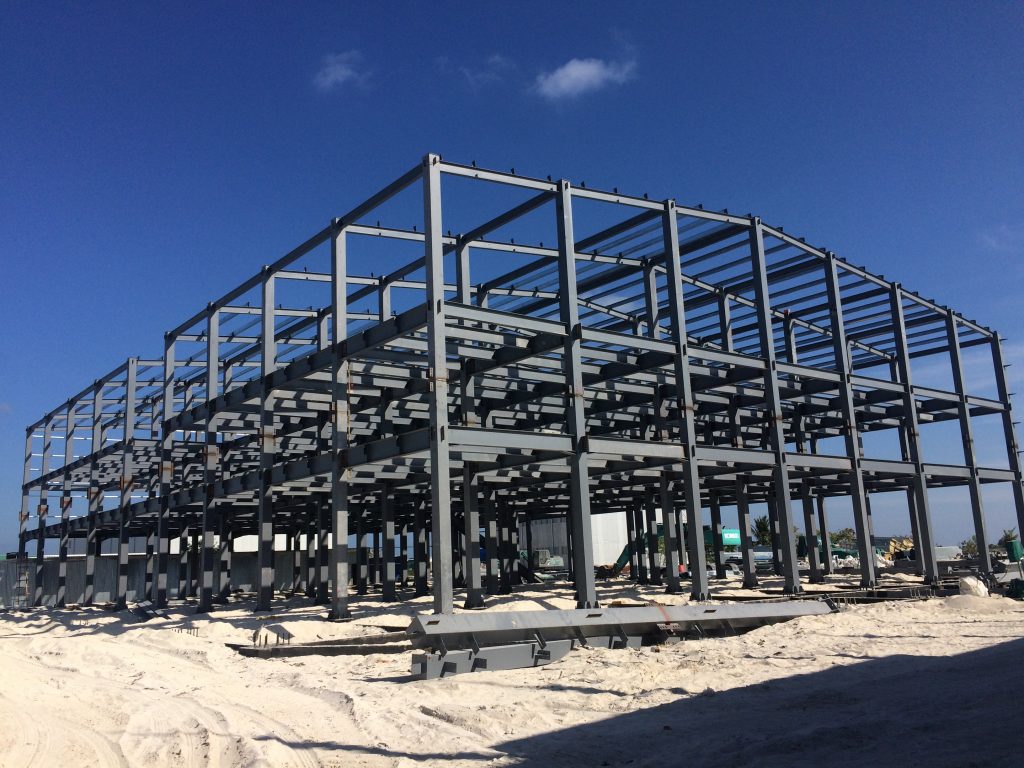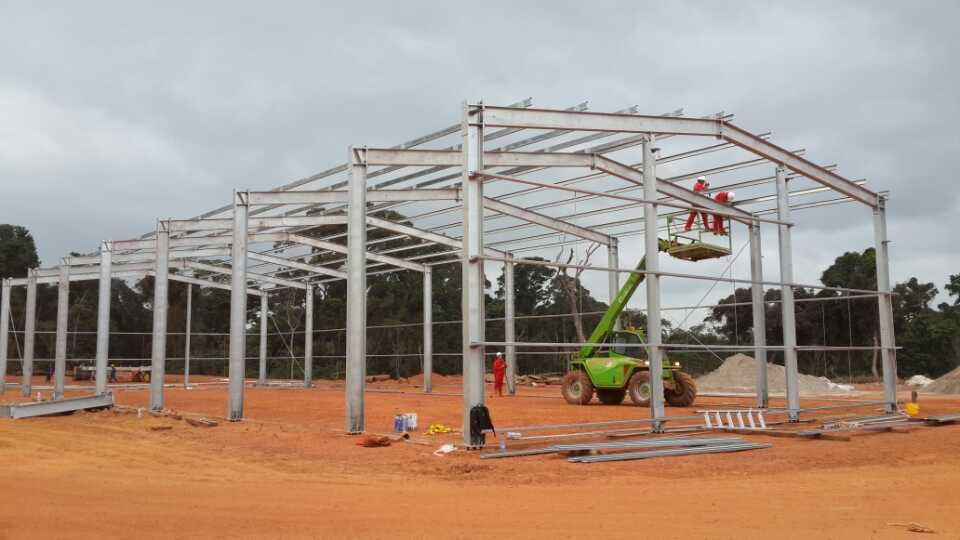Brand Name: Lida
Material: Sandwich Panel, Steel Structure
Use: Steel Structure Building
Certificate: CE (EN1090), SGS ,BV, ISO9001, ISO14001, ISO45001
Delivery time: 15 to 30 days
Payment Terms: T/T, LC
Brand Name: Lida
Material: Sandwich Panel, Steel Structure
Use: Steel Structure Building
Certificate: CE (EN1090), SGS ,BV, ISO9001, ISO14001, ISO45001
Delivery time: 15 to 30 days
Payment Terms: T/T, LC
Introduction:
Steel structure warehouses have become increasingly popular in the construction industry due to their numerous advantages and benefits. These warehouses are built using steel as the primary building material, offering exceptional strength, durability, and versatility. In this section, we will delve into the world of steel structure warehouses, exploring their advantages and why they have emerged as a preferred choice for industrial and commercial storage facilities.
The use of steel in construction has revolutionized the way warehouses are designed and built. Steel structures offer unparalleled strength, capable of withstanding heavy loads and adverse weather conditions. This makes them ideal for storing goods, equipment, and inventory that require a secure and reliable space.
One of the key advantages of steel structure warehouses is their durability. Unlike traditional building materials such as wood or concrete, steel is resistant to rotting, warping, termites, and other common issues that can compromise the integrity of a warehouse over time. This longevity translates into cost savings for businesses as they require minimal maintenance and repairs.
In addition to durability, steel structures offer remarkable flexibility in design. With advancements in technology and engineering techniques, architects can create customized layouts to meet specific storage needs. The open span design allows for maximum use of space without the need for interior columns or supports.
Moreover, steel structures are eco-friendly as they can be recycled at the end of their lifespan. This not only reduces waste but also promotes sustainability in construction practices.
In summary, steel structure warehouses provide numerous advantages over traditional building materials. Their strength, durability, flexibility in design, and eco-friendliness make them an excellent choice for businesses looking to optimize their storage facilities while minimizing long-term costs. In the following sections of this article series on understanding steel structure warehouses’ benefits further explore these advantages in detail.
When it comes to constructing warehouses, steel structures have proven to be superior in many aspects. Their key features make them the preferred choice for durability, strength, flexibility in design, and cost-effectiveness.
One of the standout features of steel structures is their exceptional durability. Steel is known for its high tensile strength, which means it can withstand heavy loads and harsh weather conditions without compromising its structural integrity. This makes steel warehouses highly resistant to damage and ensures their longevity.
Flexibility in design is another advantage offered by steel structures. With the ability to span large distances without the need for support columns, steel warehouses provide ample space for storage and operations. This flexibility allows for efficient use of space and customization according to specific requirements.
Cost-effectiveness is a crucial factor when considering warehouse construction. Steel structures offer significant cost savings compared to traditional building materials. The availability of prefabricated components and streamlined construction processes result in reduced labor costs and shorter construction times. Moreover, the low maintenance requirements of steel warehouses contribute to long-term cost savings.
In summary, the durable nature, high tensile strength, flexibility in design, and cost-effectiveness make steel structure warehouses superior choices for any business looking for a reliable storage solution that can withstand the test of time while optimizing operational efficiency.

Steel structure warehouses are highly versatile and find applications in various industries. These industrial storage facilities offer numerous benefits, making them a popular choice for businesses across different sectors.
One of the key applications of steel structure warehouses is in logistics and distribution centers. These facilities require robust structures that can withstand heavy loads and provide ample space for storing goods. Steel structures offer the ideal solution, as they are not only durable but also customizable to meet specific storage requirements.
Agricultural storage buildings also benefit from steel structures due to their strength and durability. Farmers can store their crops, equipment, and livestock securely, protecting them from harsh weather conditions and pests. The flexibility of steel structures allows for easy customization to accommodate various agricultural needs.
In addition to logistics and agriculture, steel structure warehouses are widely used in manufacturing plants. These facilities require large open spaces to house machinery, raw materials, and finished products. Steel structures provide the necessary strength and stability while allowing for efficient use of space through column-free designs.
The versatility of steel structure warehouses extends beyond these industries as well. They can be adapted for use as retail spaces, workshops, recreational centers, or even aircraft hangars. The ability to customize these structures ensures that they meet the unique requirements of each industry while providing a cost-effective solution.
Overall, the applications of steel structure warehouses in various industries highlight their adaptability and reliability. With their superior strength, durability, and flexibility, these structures continue to play a crucial role in meeting the diverse needs of businesses across different sectors.
When it comes to constructing warehouses, the choice between steel structures and traditional construction methods is a crucial decision that can greatly impact the long-term value of the building. While both options have their merits, it is important to consider the advantages of steel structures in terms of durability, cost-effectiveness, and sustainability.
Steel warehouses offer numerous benefits over concrete structures. Firstly, pre-engineered metal buildings provide superior strength and structural integrity compared to traditional construction methods. Steel has a high strength-to-weight ratio, making it capable of withstanding extreme weather conditions and natural disasters such as earthquakes or hurricanes. This inherent durability ensures that steel warehouses have a longer lifespan than their concrete counterparts.
Additionally, steel structures require minimal maintenance over time. Unlike concrete buildings that may crack or deteriorate over years due to environmental factors or wear and tear, steel warehouses are highly resistant to corrosion and degradation. This results in lower maintenance costs in the long run, saving owners significant expenses on repairs and renovations.
Moreover, opting for a pre-engineered metal building offers cost savings during both construction and operation phases. Steel structures can be fabricated off-site using computer-aided design (CAD) technology, allowing for precise manufacturing and faster assembly on-site. This reduces labor costs and construction time significantly compared to traditional methods.
Furthermore, steel is a sustainable material with high recyclability rates. Choosing steel structures promotes eco-friendly practices by reducing waste generation during construction as well as enabling future recycling at the end of its lifespan.
In conclusion, when comparing steel structure warehouses with traditional construction methods for long-term value considerations such as durability, low maintenance costs, sustainability, and cost-effectiveness clearly favor the use of pre-engineered metal buildings. By investing in a steel warehouse, owners can ensure a reliable structure that stands the test of time while minimizing expenses associated with maintenance and repairs.

When designing a steel structure warehouse, there are several factors that need to be taken into consideration to ensure optimal functionality. One of the key aspects is warehouse layout planning, which involves strategically organizing the space to maximize efficiency and productivity.
Another crucial factor is optimizing storage space. This entails utilizing the available area in the most efficient manner possible, making use of vertical space with mezzanines or multi-level racking systems. By doing so, you can increase storage capacity without compromising accessibility.
Additionally, it’s important to consider future expansion or modification needs. As businesses grow and evolve, their warehousing requirements may change. Designing a steel structure warehouse with flexibility in mind allows for easy modifications or expansions down the line, saving time and resources.
By carefully considering these factors during the design process, you can create a steel structure warehouse that not only meets your current needs but also provides room for growth and adaptability in the future.
When it comes to constructing warehouses, choosing steel as the primary building material offers numerous environmental benefits. Steel construction materials are known for their sustainability and contribute to reducing waste generation compared to conventional building materials.
One of the key advantages of steel warehouses is their recyclability. Steel is a highly recyclable material, meaning that at the end of its lifespan, it can be easily repurposed or recycled into new products. This greatly reduces the demand for raw materials and minimizes the environmental impact associated with mining and extraction.
Furthermore, steel structures generate minimal waste during construction compared to traditional building materials such as concrete or wood. The precise manufacturing process of steel components ensures minimal on-site wastage, resulting in a more efficient use of resources.
By opting for steel structure warehouses, businesses can actively contribute to sustainable practices and reduce their carbon footprint. The recyclability and reduced waste generation associated with steel construction materials make them an environmentally conscious choice for warehouse owners.
In conclusion, choosing steel as the primary building material for warehouses not only provides structural integrity but also aligns with sustainable practices. The recyclability and reduced waste generation offered by steel structures make them an excellent choice for businesses looking to minimize their environmental impact while maximizing efficiency in warehouse construction.
In conclusion, investing in a steel structure warehouse is undeniably the smart choice for long-lasting durability and cost savings. The use of steel as the primary construction material ensures that the warehouse can withstand harsh weather conditions, natural disasters, and even potential fire hazards. This durability translates into a longer lifespan for the building, reducing maintenance and repair costs over time.
Furthermore, steel structures are known for their cost-effectiveness. Compared to traditional construction methods, steel warehouses require less labor and time to assemble. This not only saves on construction expenses but also allows for quicker occupancy and utilization of the facility.
Additionally, steel is a sustainable and environmentally-friendly choice. It is 100% recyclable, meaning that at the end of its life cycle, it can be repurposed rather than becoming waste. This aligns with modern sustainability practices and reduces the environmental impact associated with construction projects.
Moreover, a steel structure warehouse offers flexibility in design and layout. With clear-span interiors and customizable configurations, it can easily adapt to changing business needs without costly renovations or expansions.
Overall, investing in a steel structure warehouse provides long-lasting durability that ensures your investment will stand strong for years to come. The cost savings achieved through reduced maintenance expenses, shorter construction timelines, sustainability benefits, and flexible design options make it an intelligent choice for businesses seeking both practicality and financial efficiency in their warehousing solutions.

Our team will use our experience to provide the professional services .
